Business Law: A Detailed Analysis of Phoenix Activity and Insolvency
VerifiedAdded on 2023/06/04
|6
|1133
|353
Report
AI Summary
This report analyzes the legal and economic implications of illegal phoenix activity within the framework of Australian business law. It examines the concept of insolvency as defined by the Corporations Act 2001 and the Bankruptcy Act 1966, highlighting the procedures involved when a business faces financial difficulties. The report focuses on the phenomenon of phoenix companies, where directors of insolvent companies transfer assets to new entities to avoid debts and taxes, defrauding creditors and shareholders. It references an article discussing the significant financial costs associated with phoenix activity and the measures taken by the Australian government, including the use of hotlines and criminal prosecutions, to combat this practice. The report underscores the importance of directors understanding their obligations and the options available during insolvency, such as voluntary winding up and solvency declarations, while also condemning actions that lead to compulsory winding up due to tax evasion and debt avoidance.
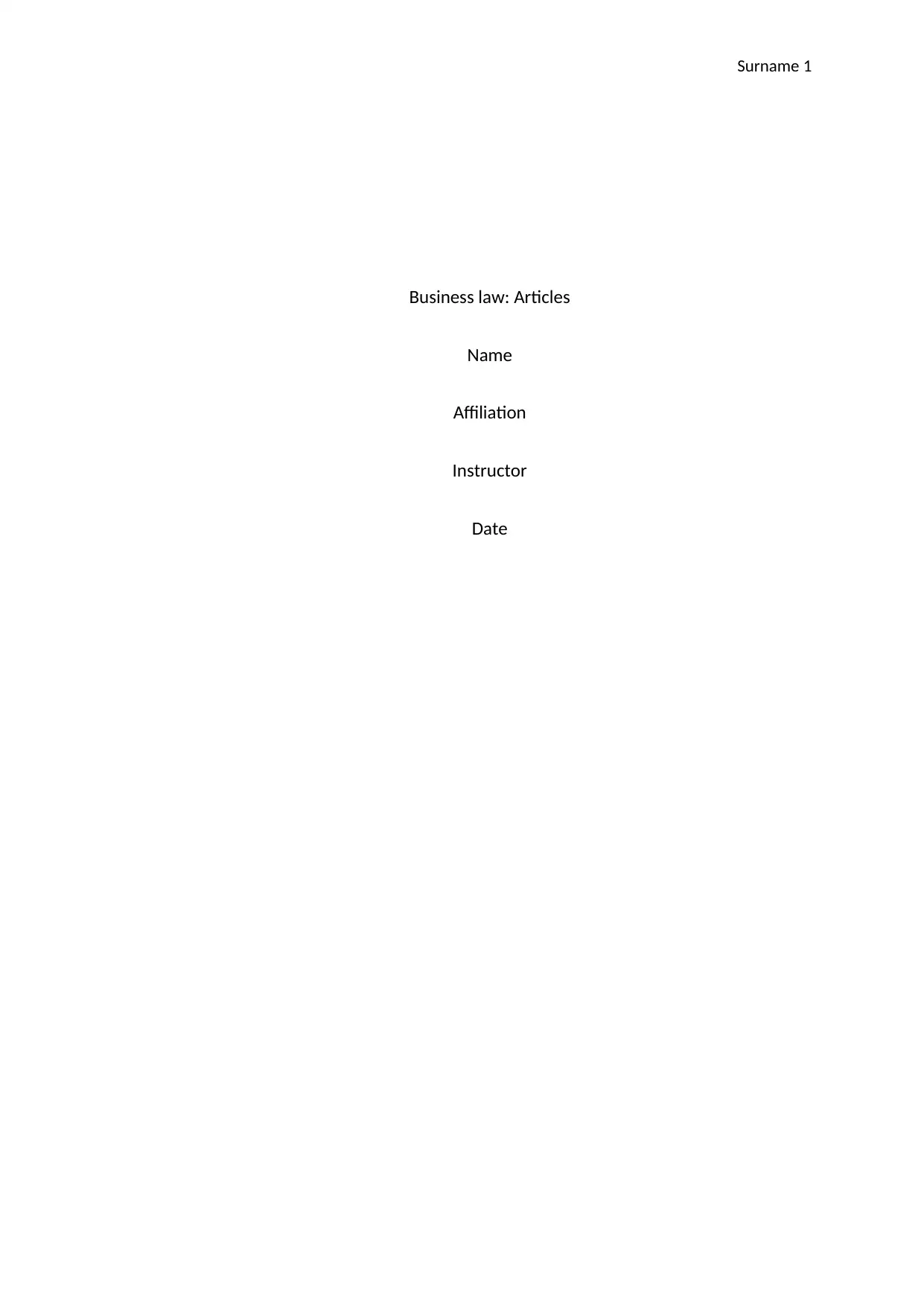
Surname 1
Business law: Articles
Name
Affiliation
Instructor
Date
Business law: Articles
Name
Affiliation
Instructor
Date
Paraphrase This Document
Need a fresh take? Get an instant paraphrase of this document with our AI Paraphraser
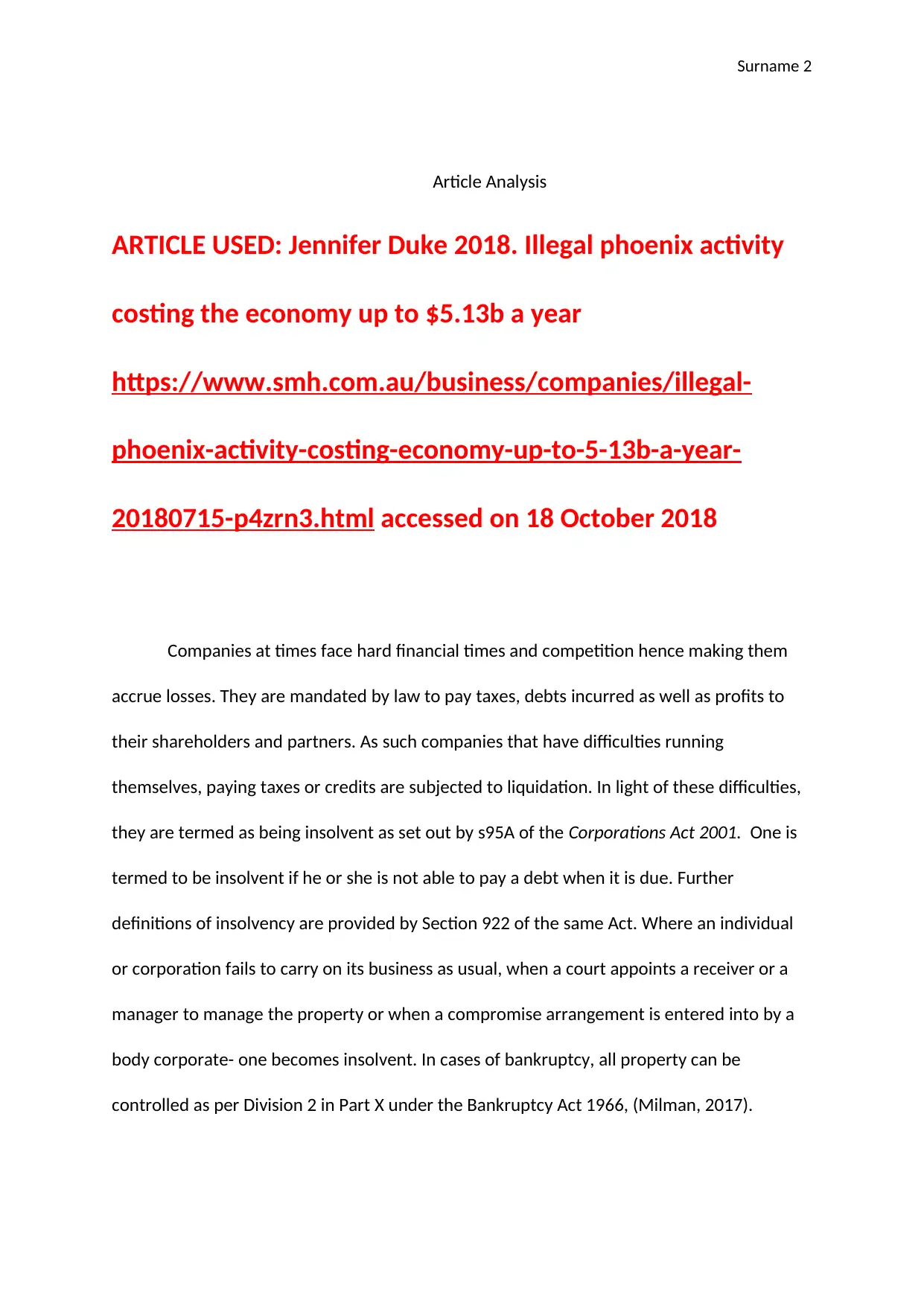
Surname 2
Article Analysis
ARTICLE USED: Jennifer Duke 2018. Illegal phoenix activity
costing the economy up to $5.13b a year
https://www.smh.com.au/business/companies/illegal-
phoenix-activity-costing-economy-up-to-5-13b-a-year-
20180715-p4zrn3.html accessed on 18 October 2018
Companies at times face hard financial times and competition hence making them
accrue losses. They are mandated by law to pay taxes, debts incurred as well as profits to
their shareholders and partners. As such companies that have difficulties running
themselves, paying taxes or credits are subjected to liquidation. In light of these difficulties,
they are termed as being insolvent as set out by s95A of the Corporations Act 2001. One is
termed to be insolvent if he or she is not able to pay a debt when it is due. Further
definitions of insolvency are provided by Section 922 of the same Act. Where an individual
or corporation fails to carry on its business as usual, when a court appoints a receiver or a
manager to manage the property or when a compromise arrangement is entered into by a
body corporate- one becomes insolvent. In cases of bankruptcy, all property can be
controlled as per Division 2 in Part X under the Bankruptcy Act 1966, (Milman, 2017).
Article Analysis
ARTICLE USED: Jennifer Duke 2018. Illegal phoenix activity
costing the economy up to $5.13b a year
https://www.smh.com.au/business/companies/illegal-
phoenix-activity-costing-economy-up-to-5-13b-a-year-
20180715-p4zrn3.html accessed on 18 October 2018
Companies at times face hard financial times and competition hence making them
accrue losses. They are mandated by law to pay taxes, debts incurred as well as profits to
their shareholders and partners. As such companies that have difficulties running
themselves, paying taxes or credits are subjected to liquidation. In light of these difficulties,
they are termed as being insolvent as set out by s95A of the Corporations Act 2001. One is
termed to be insolvent if he or she is not able to pay a debt when it is due. Further
definitions of insolvency are provided by Section 922 of the same Act. Where an individual
or corporation fails to carry on its business as usual, when a court appoints a receiver or a
manager to manage the property or when a compromise arrangement is entered into by a
body corporate- one becomes insolvent. In cases of bankruptcy, all property can be
controlled as per Division 2 in Part X under the Bankruptcy Act 1966, (Milman, 2017).
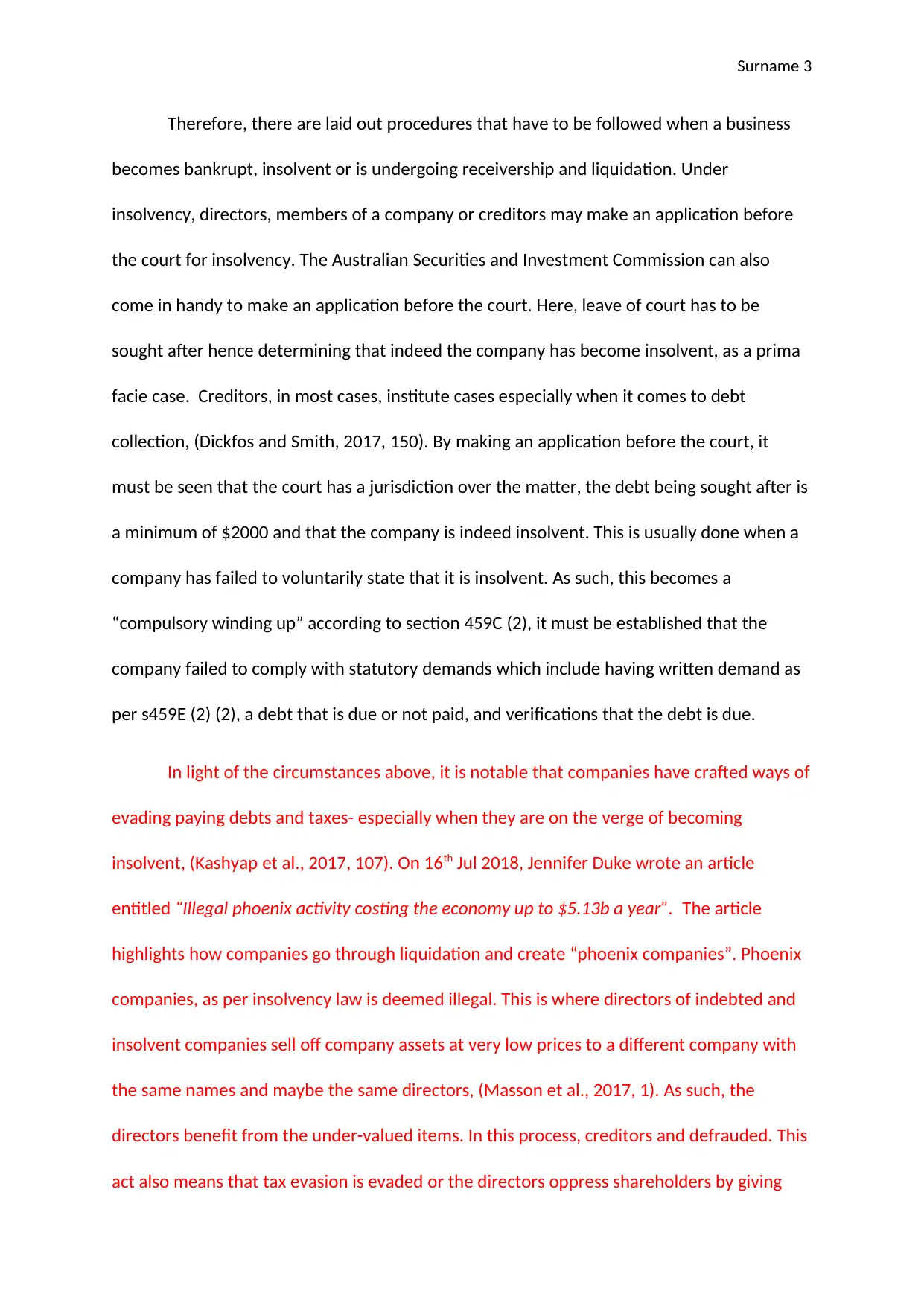
Surname 3
Therefore, there are laid out procedures that have to be followed when a business
becomes bankrupt, insolvent or is undergoing receivership and liquidation. Under
insolvency, directors, members of a company or creditors may make an application before
the court for insolvency. The Australian Securities and Investment Commission can also
come in handy to make an application before the court. Here, leave of court has to be
sought after hence determining that indeed the company has become insolvent, as a prima
facie case. Creditors, in most cases, institute cases especially when it comes to debt
collection, (Dickfos and Smith, 2017, 150). By making an application before the court, it
must be seen that the court has a jurisdiction over the matter, the debt being sought after is
a minimum of $2000 and that the company is indeed insolvent. This is usually done when a
company has failed to voluntarily state that it is insolvent. As such, this becomes a
“compulsory winding up” according to section 459C (2), it must be established that the
company failed to comply with statutory demands which include having written demand as
per s459E (2) (2), a debt that is due or not paid, and verifications that the debt is due.
In light of the circumstances above, it is notable that companies have crafted ways of
evading paying debts and taxes- especially when they are on the verge of becoming
insolvent, (Kashyap et al., 2017, 107). On 16th Jul 2018, Jennifer Duke wrote an article
entitled “Illegal phoenix activity costing the economy up to $5.13b a year”. The article
highlights how companies go through liquidation and create “phoenix companies”. Phoenix
companies, as per insolvency law is deemed illegal. This is where directors of indebted and
insolvent companies sell off company assets at very low prices to a different company with
the same names and maybe the same directors, (Masson et al., 2017, 1). As such, the
directors benefit from the under-valued items. In this process, creditors and defrauded. This
act also means that tax evasion is evaded or the directors oppress shareholders by giving
Therefore, there are laid out procedures that have to be followed when a business
becomes bankrupt, insolvent or is undergoing receivership and liquidation. Under
insolvency, directors, members of a company or creditors may make an application before
the court for insolvency. The Australian Securities and Investment Commission can also
come in handy to make an application before the court. Here, leave of court has to be
sought after hence determining that indeed the company has become insolvent, as a prima
facie case. Creditors, in most cases, institute cases especially when it comes to debt
collection, (Dickfos and Smith, 2017, 150). By making an application before the court, it
must be seen that the court has a jurisdiction over the matter, the debt being sought after is
a minimum of $2000 and that the company is indeed insolvent. This is usually done when a
company has failed to voluntarily state that it is insolvent. As such, this becomes a
“compulsory winding up” according to section 459C (2), it must be established that the
company failed to comply with statutory demands which include having written demand as
per s459E (2) (2), a debt that is due or not paid, and verifications that the debt is due.
In light of the circumstances above, it is notable that companies have crafted ways of
evading paying debts and taxes- especially when they are on the verge of becoming
insolvent, (Kashyap et al., 2017, 107). On 16th Jul 2018, Jennifer Duke wrote an article
entitled “Illegal phoenix activity costing the economy up to $5.13b a year”. The article
highlights how companies go through liquidation and create “phoenix companies”. Phoenix
companies, as per insolvency law is deemed illegal. This is where directors of indebted and
insolvent companies sell off company assets at very low prices to a different company with
the same names and maybe the same directors, (Masson et al., 2017, 1). As such, the
directors benefit from the under-valued items. In this process, creditors and defrauded. This
act also means that tax evasion is evaded or the directors oppress shareholders by giving
⊘ This is a preview!⊘
Do you want full access?
Subscribe today to unlock all pages.

Trusted by 1+ million students worldwide
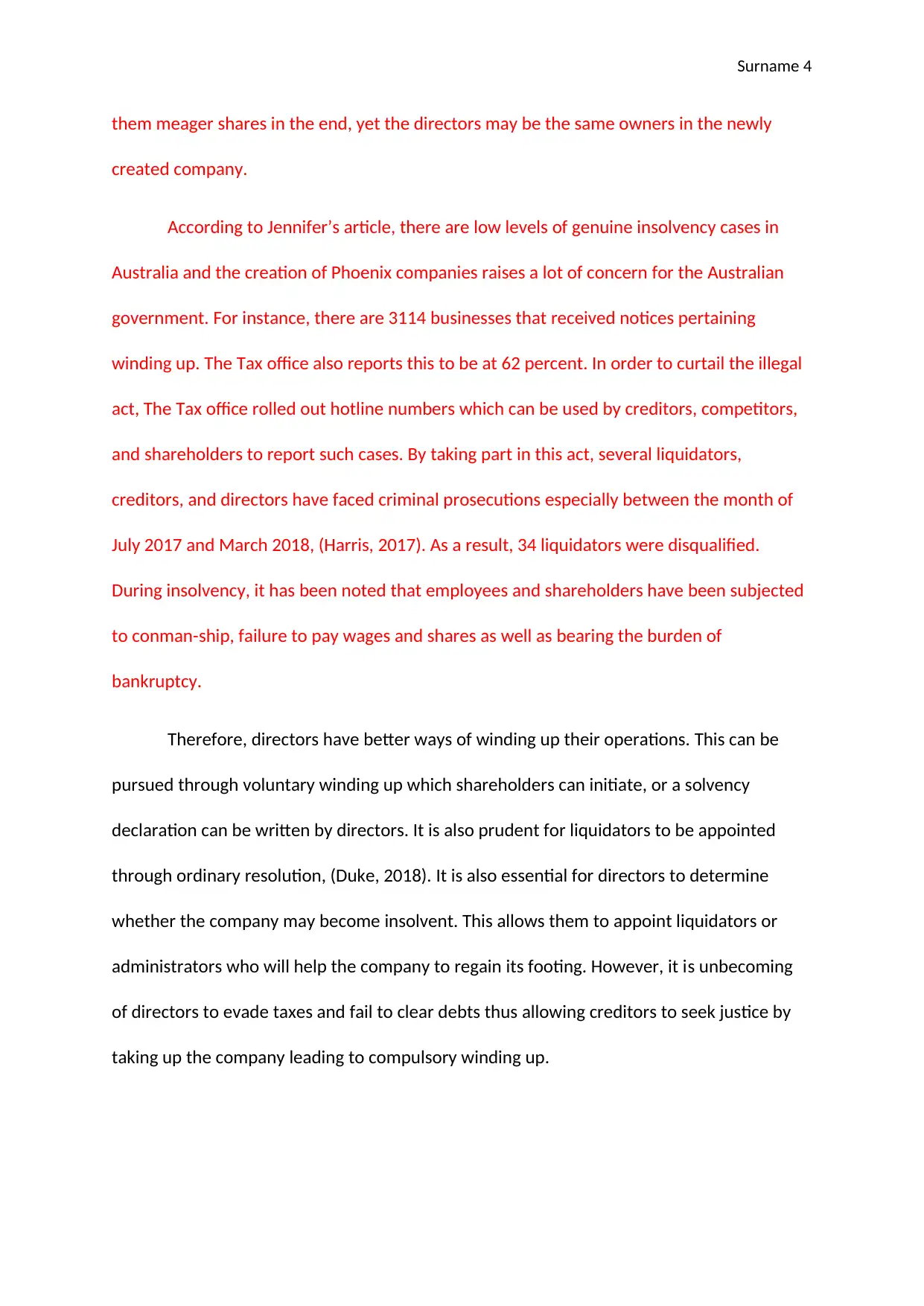
Surname 4
them meager shares in the end, yet the directors may be the same owners in the newly
created company.
According to Jennifer’s article, there are low levels of genuine insolvency cases in
Australia and the creation of Phoenix companies raises a lot of concern for the Australian
government. For instance, there are 3114 businesses that received notices pertaining
winding up. The Tax office also reports this to be at 62 percent. In order to curtail the illegal
act, The Tax office rolled out hotline numbers which can be used by creditors, competitors,
and shareholders to report such cases. By taking part in this act, several liquidators,
creditors, and directors have faced criminal prosecutions especially between the month of
July 2017 and March 2018, (Harris, 2017). As a result, 34 liquidators were disqualified.
During insolvency, it has been noted that employees and shareholders have been subjected
to conman-ship, failure to pay wages and shares as well as bearing the burden of
bankruptcy.
Therefore, directors have better ways of winding up their operations. This can be
pursued through voluntary winding up which shareholders can initiate, or a solvency
declaration can be written by directors. It is also prudent for liquidators to be appointed
through ordinary resolution, (Duke, 2018). It is also essential for directors to determine
whether the company may become insolvent. This allows them to appoint liquidators or
administrators who will help the company to regain its footing. However, it is unbecoming
of directors to evade taxes and fail to clear debts thus allowing creditors to seek justice by
taking up the company leading to compulsory winding up.
them meager shares in the end, yet the directors may be the same owners in the newly
created company.
According to Jennifer’s article, there are low levels of genuine insolvency cases in
Australia and the creation of Phoenix companies raises a lot of concern for the Australian
government. For instance, there are 3114 businesses that received notices pertaining
winding up. The Tax office also reports this to be at 62 percent. In order to curtail the illegal
act, The Tax office rolled out hotline numbers which can be used by creditors, competitors,
and shareholders to report such cases. By taking part in this act, several liquidators,
creditors, and directors have faced criminal prosecutions especially between the month of
July 2017 and March 2018, (Harris, 2017). As a result, 34 liquidators were disqualified.
During insolvency, it has been noted that employees and shareholders have been subjected
to conman-ship, failure to pay wages and shares as well as bearing the burden of
bankruptcy.
Therefore, directors have better ways of winding up their operations. This can be
pursued through voluntary winding up which shareholders can initiate, or a solvency
declaration can be written by directors. It is also prudent for liquidators to be appointed
through ordinary resolution, (Duke, 2018). It is also essential for directors to determine
whether the company may become insolvent. This allows them to appoint liquidators or
administrators who will help the company to regain its footing. However, it is unbecoming
of directors to evade taxes and fail to clear debts thus allowing creditors to seek justice by
taking up the company leading to compulsory winding up.
Paraphrase This Document
Need a fresh take? Get an instant paraphrase of this document with our AI Paraphraser
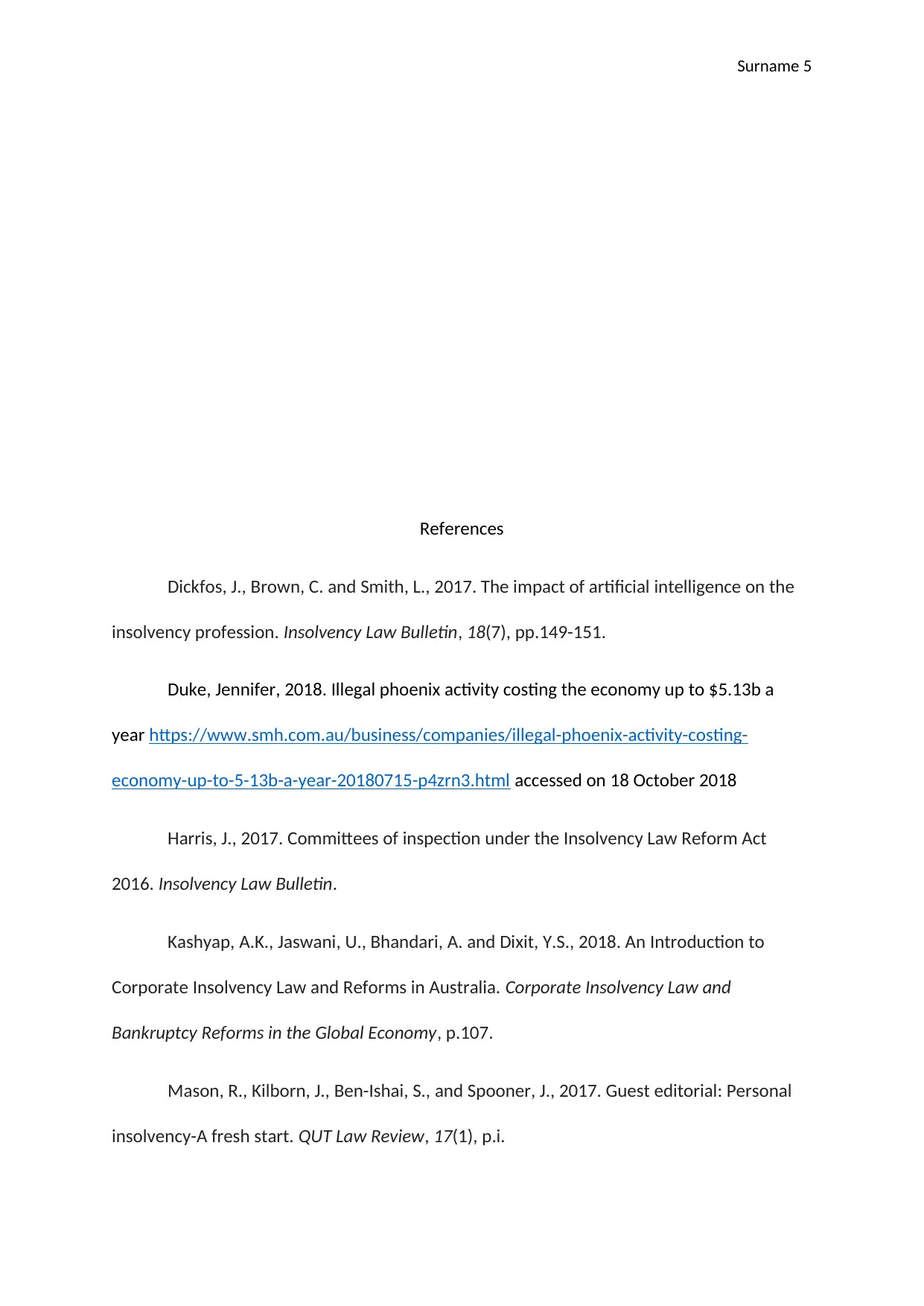
Surname 5
References
Dickfos, J., Brown, C. and Smith, L., 2017. The impact of artificial intelligence on the
insolvency profession. Insolvency Law Bulletin, 18(7), pp.149-151.
Duke, Jennifer, 2018. Illegal phoenix activity costing the economy up to $5.13b a
year https://www.smh.com.au/business/companies/illegal-phoenix-activity-costing-
economy-up-to-5-13b-a-year-20180715-p4zrn3.html accessed on 18 October 2018
Harris, J., 2017. Committees of inspection under the Insolvency Law Reform Act
2016. Insolvency Law Bulletin.
Kashyap, A.K., Jaswani, U., Bhandari, A. and Dixit, Y.S., 2018. An Introduction to
Corporate Insolvency Law and Reforms in Australia. Corporate Insolvency Law and
Bankruptcy Reforms in the Global Economy, p.107.
Mason, R., Kilborn, J., Ben-Ishai, S., and Spooner, J., 2017. Guest editorial: Personal
insolvency-A fresh start. QUT Law Review, 17(1), p.i.
References
Dickfos, J., Brown, C. and Smith, L., 2017. The impact of artificial intelligence on the
insolvency profession. Insolvency Law Bulletin, 18(7), pp.149-151.
Duke, Jennifer, 2018. Illegal phoenix activity costing the economy up to $5.13b a
year https://www.smh.com.au/business/companies/illegal-phoenix-activity-costing-
economy-up-to-5-13b-a-year-20180715-p4zrn3.html accessed on 18 October 2018
Harris, J., 2017. Committees of inspection under the Insolvency Law Reform Act
2016. Insolvency Law Bulletin.
Kashyap, A.K., Jaswani, U., Bhandari, A. and Dixit, Y.S., 2018. An Introduction to
Corporate Insolvency Law and Reforms in Australia. Corporate Insolvency Law and
Bankruptcy Reforms in the Global Economy, p.107.
Mason, R., Kilborn, J., Ben-Ishai, S., and Spooner, J., 2017. Guest editorial: Personal
insolvency-A fresh start. QUT Law Review, 17(1), p.i.
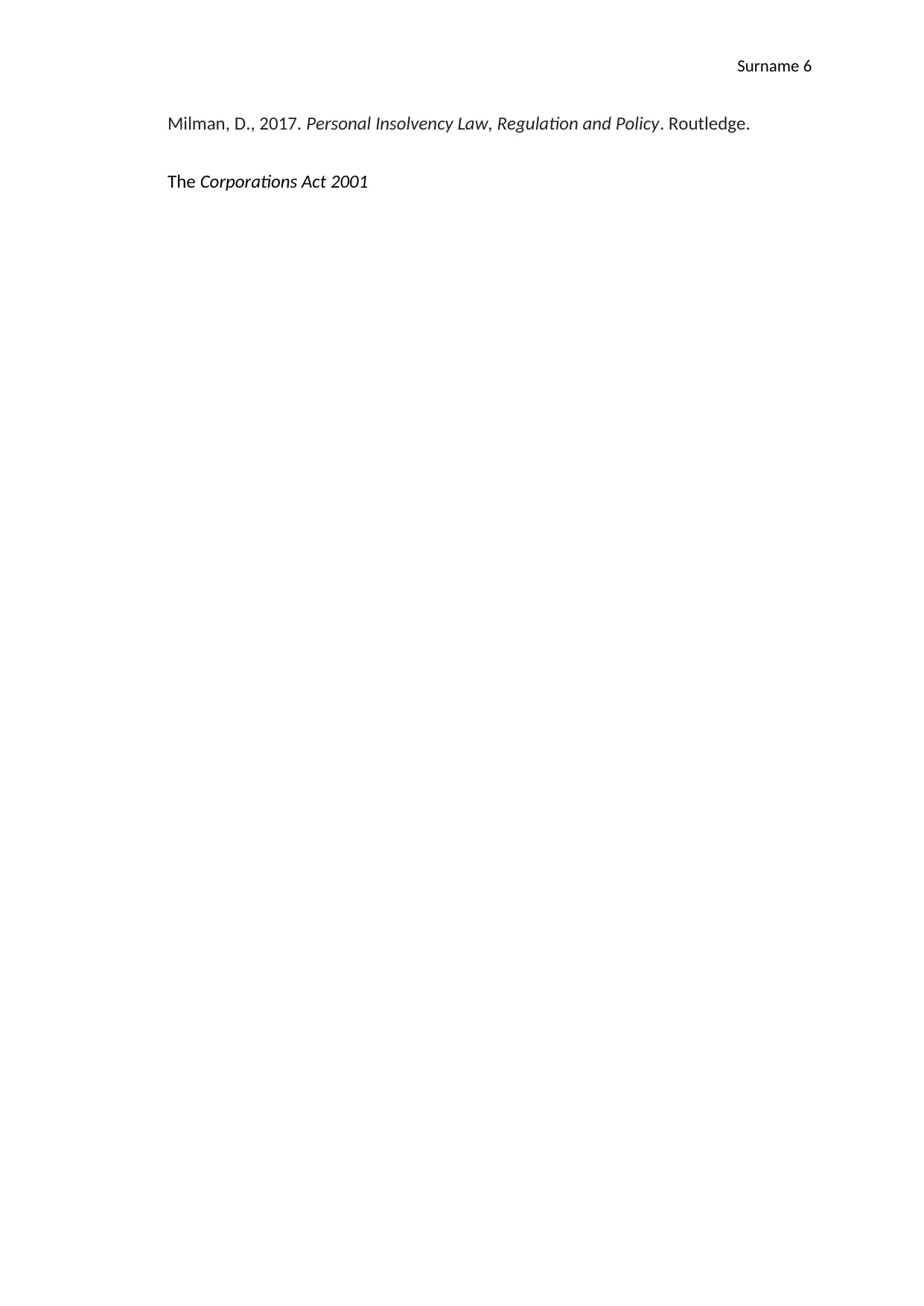
Surname 6
Milman, D., 2017. Personal Insolvency Law, Regulation and Policy. Routledge.
The Corporations Act 2001
Milman, D., 2017. Personal Insolvency Law, Regulation and Policy. Routledge.
The Corporations Act 2001
⊘ This is a preview!⊘
Do you want full access?
Subscribe today to unlock all pages.

Trusted by 1+ million students worldwide
1 out of 6
Related Documents
Your All-in-One AI-Powered Toolkit for Academic Success.
+13062052269
info@desklib.com
Available 24*7 on WhatsApp / Email
![[object Object]](/_next/static/media/star-bottom.7253800d.svg)
Unlock your academic potential
Copyright © 2020–2025 A2Z Services. All Rights Reserved. Developed and managed by ZUCOL.





